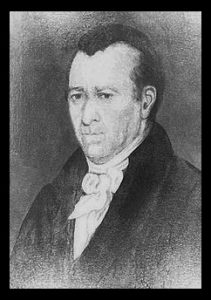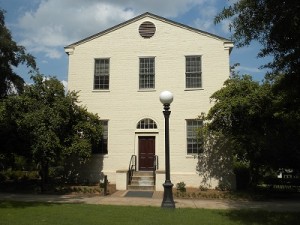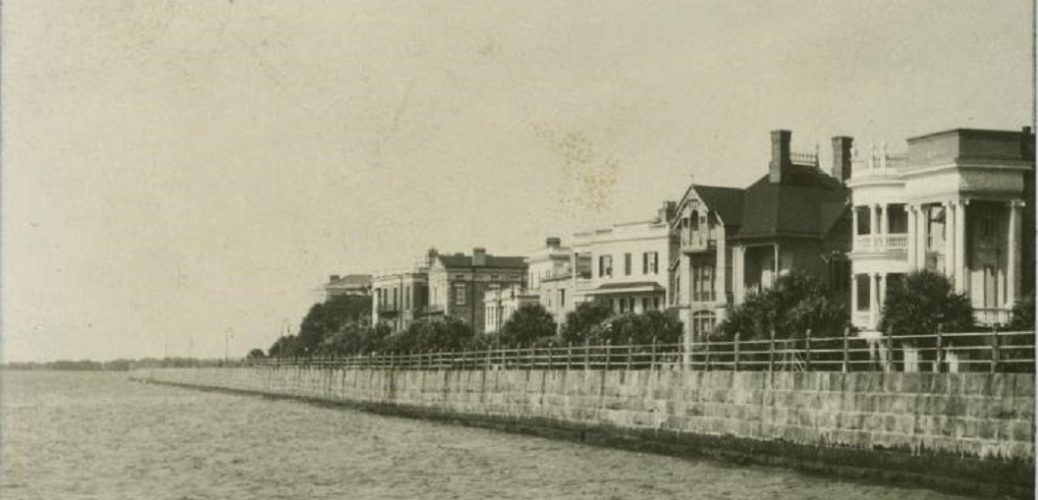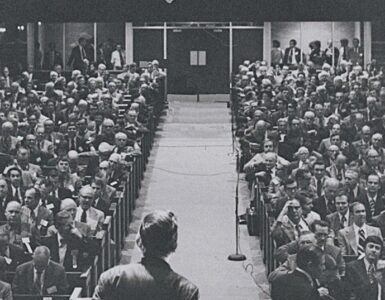 On January 25, 1767, the ship from Ireland bearing William Waddel, his wife, and five daughters made port in Charleston, South Carolina. He later moved the family from the Low-Country to the hills of what is currently Iredell County (at that time a part of Rowan County), North Carolina, and settled near the waters of the Yadkin River. On July 29, 1770 diminutive and premature Moses was born the third and last of three sons in the recently constructed Waddel home. His education was obtained as he had the opportunity and his family could afford the fees. An important educational influence on his life was the Presbyterian clergyman and teacher James Hall (1744-1826) who tutored him and in later years founded Ebenezer Academy at Bethany Church near Statesville. Rev. Hall had received his education at Nassau Hall, in New Jersey during the presidency of John Witherspoon.
On January 25, 1767, the ship from Ireland bearing William Waddel, his wife, and five daughters made port in Charleston, South Carolina. He later moved the family from the Low-Country to the hills of what is currently Iredell County (at that time a part of Rowan County), North Carolina, and settled near the waters of the Yadkin River. On July 29, 1770 diminutive and premature Moses was born the third and last of three sons in the recently constructed Waddel home. His education was obtained as he had the opportunity and his family could afford the fees. An important educational influence on his life was the Presbyterian clergyman and teacher James Hall (1744-1826) who tutored him and in later years founded Ebenezer Academy at Bethany Church near Statesville. Rev. Hall had received his education at Nassau Hall, in New Jersey during the presidency of John Witherspoon.
Moses Waddel went on for further study at Hampden-Sydney College in Virginia graduating the fall of 1791. He came before Hanover Presbytery to become a ministerial candidate, then was licensed to preach on May 12, 1792. Following a brief stay and pastoral ministry in Virginia, he opened a school in Columbia County, Georgia, about two miles east of the town of Appling, where he also served the Carmel Church.
In 1795, Moses married the sister of John C. Calhoun, Catherine. John had been a student of Rev. Waddel when he taught in Georgia. Moses and Catherine had a brief life together because of her death within a year of their marriage due to complications from childbirth. The infant daughter soon followed her mother to the grave. In 1800, Moses married Elizabeth Woodson Pleasants and they enjoyed the blessings of four sons and two daughters.
 Moses Waddel left Georgia in 1801 to open a school on the Savannah River in Vienna, Abbeville District, South Carolina. His residential proximity to the Hopewell Church (also called the Lower Long Cane Church) gave him the opportunity to be its pastor. He moved his academy to Willington and resigned from the call to the Hopewell Church in 1804. One writer described the Willington school property in its early days as the campus developed.
Moses Waddel left Georgia in 1801 to open a school on the Savannah River in Vienna, Abbeville District, South Carolina. His residential proximity to the Hopewell Church (also called the Lower Long Cane Church) gave him the opportunity to be its pastor. He moved his academy to Willington and resigned from the call to the Hopewell Church in 1804. One writer described the Willington school property in its early days as the campus developed.
For educational purposes he had at first but a log house, ventilated by a wide open passage; and as the place seemed so strait, and the number of pupils continually increased, soon a great number of little wooden tents or domiciles surrounded the log cabin, peeping out here and there from among the Chinquapin bushes—some with little pipes of wooden chimneys plastered with mud—others more pretentiously built of brick looking decrepit and rickety; yet supplying all that the erratic wishes of a student might require. (Howe, 2:143)
Henry Alexander White adds to the description of Willington Academy’s campus life noting that when George McDuffie entered the school there were about one hundred eighty pupils who were called to class by the blowing of a horn.
Dr. Waddel continued to lead the Willington Academy until he left in May 1819 to accept the presidency of what we know as the University of Georgia. The school had fallen on hard times but Dr. Waddel was able to stabilize the institution and see it grow through his efforts. During his service to the university, he was also the founding pastor of the First Presbyterian Church in Athens. Dr. Waddel resigned from the University of Georgia in August 1829, but he continued to work in Athens until he returned to Willington in February 1830.
 Moses Waddel suffered a stroke in September 1836 and was moved back to Georgia to the residence of his son in Athens where he died July 21, 1840. Rev. Waddel had been given a Doctor of Divinity by South Carolina College in 1807. His tireless and selfless work not only as a minister but as an educator provided both spiritual guidance and education for thousands of church members and students.
Moses Waddel suffered a stroke in September 1836 and was moved back to Georgia to the residence of his son in Athens where he died July 21, 1840. Rev. Waddel had been given a Doctor of Divinity by South Carolina College in 1807. His tireless and selfless work not only as a minister but as an educator provided both spiritual guidance and education for thousands of church members and students.
The children of Moses and Elizabeth included four sons—James Pleasants Waddel, who was a professor in the University of Georgia for many years; John N. Waddel became the chancellor of the University of Mississippi; Isaac W. Waddel followed in his father’s footsteps as a minister; and W. W. Waddel was a physician.
Barry Waugh
Notes–The header of The Battery in Charleston is from the New York Public Library Digital Collection and is dated 1862 to 1962; it likely could be dated better by someone who knows the history of The Battery; it looks closer to the latter than the former date. Books used include: Walter Edgar, South Carolina: A History, Columbia: U.S.C. Press, 1998; Henry A. White’s piece titled, “Moses Waddell and the Willington Academy in South Carolina,” in Southern Presbyterian Leaders, 1911; and The Great Doctor Waddell, by James L. McLeod, 1985. “Howe” refers to George Howe’s two-volume History of the Presbyterian Church in South Carolina. The photographs of the University of Georgia historical marker and the campus building were taken by the author. The building with the black lamp post out front is Waddel Hall, 1821. The historical marker is at the University of Georgia arch as one enters the old campus by the Holmes/Hunter Academic Building. For a recent study of Moses Waddel see Tom Horton, The American Eton: Moses Waddel’s Famed Willington Academy, vol. 4 in the series, History’s Lost Moments, 2012.





